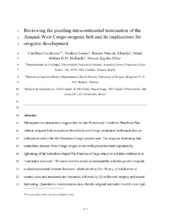| dc.contributor.author | Cavalcante, Carolina | |
| dc.contributor.author | Fossen, Haakon | |
| dc.contributor.author | Almeida, Renato Paes de | |
| dc.contributor.author | Hollanda, M.H.B.M. | |
| dc.contributor.author | Egydio-Silva, Marcos | |
| dc.date.accessioned | 2020-03-17T10:38:39Z | |
| dc.date.available | 2020-03-17T10:38:39Z | |
| dc.date.issued | 2019 | |
| dc.Published | Cavalcante GCG, Fossen H, Almeida RP, Hollanda MHBM, Egydio-Silva M. Reviewing the puzzling intracontinental termination of the Araçuaí-West Congo orogenic belt and its implications for orogenic development. Precambrian Research. 2019;322:85-98 | eng |
| dc.identifier.issn | 1872-7433 | |
| dc.identifier.issn | 0301-9268 | |
| dc.identifier.uri | https://hdl.handle.net/1956/21511 | |
| dc.description.abstract | Palinspastic reconstructions suggest that the late Proterozoic–Cambrian Brasiliano/Pan-African orogenic belt in southeast Brazil and west Congo terminated northwards into an embayment within the São Francisco-Congo cratonic unit. The orogenic shortening that created the Araçuaí-West Congo orogen in this embayment has been explained by tightening of the horseshoe-shaped São Francisco-Congo craton in a fashion referred to as “nutcracker tectonics”. We show that this model is incompatible with the general orogenic evolution proposed in recent literature, which involves (1) ∼50 m.y. of subduction of oceanic crust and associated arc formation, followed by (2) collisional orogeny and crustal thickening. Quantitative considerations show that the original nutcracker model is too rigid to explain even the second, crustal thickening part, let alone any long pre-collisional history. To soften the model, we suggest that the so-called São Francisco – Congo bridge was broken by a ∼150 km wide orogenic corridor along the current African Atlantic margin. This corridor adds sufficient mobility to the system to explain the orogenic thickening of the crust to 60–65 km. However, even with this additional softening the confined nature of this orogen is incompatible with prolonged arc development. We therefore suggest that oceanic crust was nonexistent or very limited in the Macaúbas basin, and reject the widely published model involving ∼50 m.y. of subduction of oceanic crust and related arc development. Instead, we find strong support for a hot intracontinental orogen model in the currently available P-T, geochronologic, petrographic and structural data. In this model, extensive melting and flow of the middle crust is likely to have caused spreading of the upper crust in an orogenic setting that was created by collisions along the N, W and S margins of the São Francisco craton from ∼630 Ma. | en_US |
| dc.language.iso | eng | eng |
| dc.publisher | Elsevier | eng |
| dc.rights | Attribution-Non Commercial-No Derivatives CC BY-NC-ND | eng |
| dc.rights.uri | http://creativecommons.org/licenses/by-nc-nd/4.0/ | eng |
| dc.title | Reviewing the puzzling intracontinental termination of the Araçuaí-West Congo orogenic belt and its implications for orogenic development | eng |
| dc.type | Peer reviewed | en_US |
| dc.type | Journal article | en_US |
| dc.date.updated | 2020-01-13T06:38:45Z | |
| dc.description.version | acceptedVersion | |
| dc.rights.holder | Copyright 2019 Elsevier | eng |
| dc.identifier.doi | https://doi.org/10.1016/j.precamres.2018.12.025 | |
| dc.identifier.cristin | 1653132 | |
| dc.source.journal | Precambrian Research | |
| dc.source.pagenumber | 85-98 | |
| dc.identifier.citation | Precambrian Research. 2019, 322, 85-98. | |
| dc.source.volume | 322 | |

